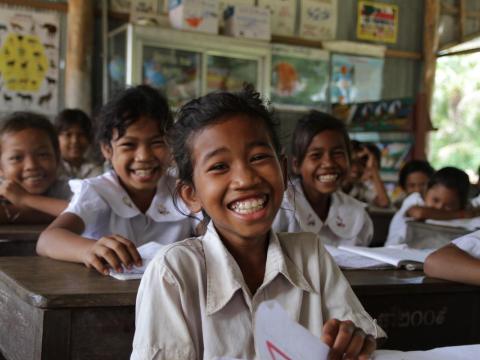Peace can blossom through Education: World Vision’s holistic approach to learning for lasting peace

By Ana Tenorio, Global Education Director
Today, 800M people live in countries affected by fragility, conflict, and violence.[i] Global estimates indicate that one billion children – over half of all children aged 2-17 years – have experienced physical, sexual or emotional violence in the past 12 months alone. And nearly 3 in 4 children aged 2-4 years repeatedly suffer physical punishment or psychological violence at the hands of parents or caregivers.[ii] In addition, there are 224 million school-aged children affected by crisis of which 72 million do not have access to school.[iii]
While the numbers above are daunting, these shocking statistics can be significantly reduced with increased investments, targeted action and a holistic approach to prevent violence, foster inclusive equitable learning and social cohesion for lasting peace. At World Vision we believe in addressing the root causes of vulnerability and violence that prevent children from experiencing fullness of life in peaceful societies. The path to prosperity and peace cannot be fulfilled without Education. Our community-led, whole-child model helps establish sustainable child-wellbeing solutions for all children from birth, through childhood and adolescence.
Compelling evidence highlights the importance of the early years in setting the foundation for harmonious and positive relationships. Especially in contexts were children and families are experiencing toxic stress. Research on brain development indicate that toxic stress strongly increases a child’s risk of developing impaired stress- and emotion-regulation systems, depression, anxiety, violent behavior, substance abuse and harmful relationships in adulthood.[iv]
Fortunately, research also affirms that supportive and responsive relationships with caring adults in the early years can prevent or reverse the damaging effects of toxic stress. [v] This is why World Vision is committed to reach families in the most challenging situations as early as possible. In Rwanda for example, our integrated Go Baby Go approach supported Congolese refugee caregivers in positive strategies to cope with stress and in providing nurturing care that fostered development and protected children from toxic stress. In Palestine the emphasis on maternal wellbeing was crucial as it significantly reduced maternal depression and children’s developmental delays. In Zambia, our Learning Roots approach reached caregivers, teachers and communities through playful and peace-affirming values such as the importance of unity, dialogue, collaboration, and positive citizenship.
Building from our approaches in the early years, World Vision’s whole child model in formal and non-formal settings seeks to achieve foundational learning with an emphasis on gender equality, disability and social inclusion. In Peru integrating learning and tenderness in a school with Venezuela and Peruvian students fostered inclusion, embracing diversity, social cohesion with social-emotional well-being as the foundation for learning and peaceful relationships. Through the Unlock Literacy and the "Drop Everything And Read" initiative, Felicien, a 12 year-old boy who was discriminated because of his albinism and vision impairment, is now supported by peers who are embracing the values of diversity and inclusion in learning.
Our Positive Youth Development approach and IMPACT+ model empowers adolescents to become active citizens with competence, confidence, and a sense of connection to succeed not only in life but also to make a positive difference in the world to end violence against children. The Empowering Children as Peacebuilders approach implemented in the Kakuma refugee camp in Kenya empowered children to become peace champions in their communities, as well as child-rights advocates.
The pressures our society face today are compounded by multiple crises and the demands we are imposing on our planet. Education is crucial to succeed in addressing today’s challenges. We need Education systems that celebrate and promote diversity, equality, and social inclusion. An Education that nurtures a broad set of skills for peace to blossom and be sustained across multiple generations.
[i] World Bank – IDA Fragility, Conflict & Violence
[ii] https://www.who.int/activities/preventing-violence-against-children#:~:text=Every%20five%20minutes%2C%20a%20child,the%20past%2012%20months%20alone.
[iii] Education Cannot Wait New Global Estimates (June 2023) https://www.educationcannotwait.org/sites/default/files/2023-06/f_ecw1022_globalestimates_paper_mech.pdf
[iv] Leckman, J. F., Panter-Brick, C., and Salah, R., eds., ch. 5, 7 and 11 in Pathways to Peace: The transformative power of children and families, MIT Press, Cambridge, Mass., 2014
[v] https://developingchild.harvard.edu/science/key-concepts/toxic-stress/